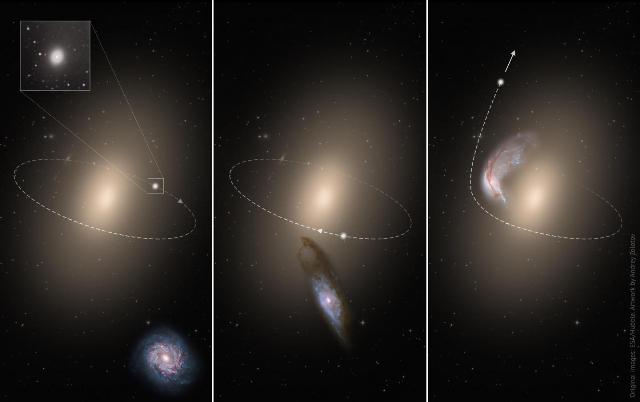Apr 25 2015
Astronomers think, that there are dozens of billions undetectable free floating planets that straggle along our Milky Way galaxy, being not gravitationally bound to any star.
 "An artwork demonstrates several stages of the process of a close three-body encounter with a gravitation kick of a compact elliptical galaxy that explains the phenomenon of an isolated compact elliptical galaxy. Credit:ESA/Hubble. Artwork by Andrey Zolotov"
"An artwork demonstrates several stages of the process of a close three-body encounter with a gravitation kick of a compact elliptical galaxy that explains the phenomenon of an isolated compact elliptical galaxy. Credit:ESA/Hubble. Artwork by Andrey Zolotov"
Moreover, there are about two dozens known stars that escaped from our Galaxy at high velocities, and even one runaway star cluster hosting a million stars that fled the giant galaxy Messier87 in the Virgo cluster. All those objects have one thing in common - they have been thrown away from their home systems by gravitational perturbations. Two Russian astronomers, Igor Chilingarian and Ivan Zolotukhin of Sternberg Astronomical Institute, Moscow State University, who currently works at Harvard-Smithsonian Center for Astrophysics, USA and L'Institut de Recherche en Astrophysique et Planétologie, Toulouse, France, respectively, have shown that some galaxies can also be thrown away from their host clusters and groups by interacting with their neighbours.
Until 2006 scientists knew only 6 extremely compact elliptical galaxies like the Andromeda satellite Messier32 that host up-to several billion stars. They are so small, that they look like stripped cores of ordinary galaxies. All these stellar systems were found next to giant galaxies in centers of large clusters of galaxies. Numerical simulations demonstrated that these compact ellipticals could be the remnants of ancient larger galaxies, stripped out to the central core by tidal interactions with a massive galaxy after falling on it. In 2009 Igor Chilingarian discovered another 20 such rare galaxies.
However, in 2013, the first compact elliptical was found far away from any massive galaxy, so that it became unclear where it came from and whether it was formed through tidal stripping. It became clear that astronomers should search such objects not only in clusters of galaxies and groups, but also between them.
Chilingarian and Zolotukhin have processed a huge amount of astronomical data, publicly available thanks to the Virtual Observatory initiative. They discovered almost 200 additional compact ellipticals. Most of them, as expected, were found inside massive clusters and groups of galaxies, but 11 are indeed isolated, flying free in space some millions of light years from nearest clusters.
"We asked ourselves, how we could explain them?", -- stated Igor Chilingarian, the first author of the paper that will appear in the journal Science. As far as isolated compact ellipticals and those found in clusters shared very similar properties, it looked like they must have had the common origin in the past. Initially, a massive galaxy in a cluster striped away outer parts of a an in-falling smaller galaxy, leaving behind only a compact core, and later, some other galaxy threw this core away into the inter-cluster space.
Similar processes are known to take place near Milky Way's center: a supermassive black hole can fling away one of two stars in a binary system, that came too close to it, and swallow the other one.
"This is the same phenomenon, but working on a different scale, a slingshot effect, when during a three-body encounter the lightest body flies away from the system", -- explained Zolotukhin. To support this statement, astronomers analyzed the velocity spread of compact ellipticals in galaxy clusters that shows that some of them are on a verge of escaping their host clusters.
"These small galaxies face a lonely future, exiled from galaxy clusters they were formed and used to live in", -- Igor Chilingarian said. But this helps them to survive, because otherwise they would spiral in and be devoured by their massive hosts in about a billion years.
To escape the Earth, a body must be thrown faster than 11 km/s, to leave the Solar system from the Earth's orbit that speed is over 42 km/s. A galaxy has to reach approximately 2500 km/s in order to run away, astronomers calculated. Chilingarian and Zolotukhin hope their discovery will shed light on the structure and evolution of compact elliptical galaxies, because they think that these galaxies don't contain dark matter that is thought keeps stable most galaxies of other types.
This is the first time when an astronomical discovery published in interdisciplinary journal made without a single new photon collected but based solely on publicly available observations. This is a new era in astronomy, when any Internet user can use observations in archives and make discoveries from her or his office without the need to travel to an observatory and collect the data.
Source: http://www.msu.ru/